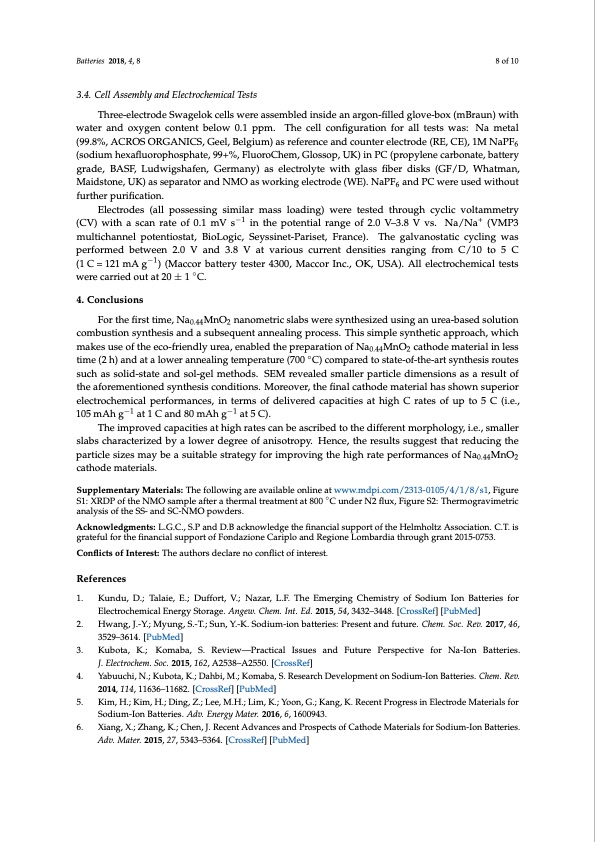
PDF Publication Title:
Text from PDF Page: 008
Batteries 2018, 4, 8 8 of 10 3.4. Cell Assembly and Electrochemical Tests Three-electrode Swagelok cells were assembled inside an argon-filled glove-box (mBraun) with water and oxygen content below 0.1 ppm. The cell configuration for all tests was: Na metal (99.8%, ACROS ORGANICS, Geel, Belgium) as reference and counter electrode (RE, CE), 1M NaPF6 (sodium hexafluorophosphate, 99+%, FluoroChem, Glossop, UK) in PC (propylene carbonate, battery grade, BASF, Ludwigshafen, Germany) as electrolyte with glass fiber disks (GF/D, Whatman, Maidstone, UK) as separator and NMO as working electrode (WE). NaPF6 and PC were used without further purification. Electrodes (all possessing similar mass loading) were tested through cyclic voltammetry (CV) with a scan rate of 0.1 mV s−1 in the potential range of 2.0 V–3.8 V vs. Na/Na+ (VMP3 multichannel potentiostat, BioLogic, Seyssinet-Pariset, France). The galvanostatic cycling was performed between 2.0 V and 3.8 V at various current densities ranging from C/10 to 5 C (1 C = 121 mA g−1) (Maccor battery tester 4300, Maccor Inc., OK, USA). All electrochemical tests were carried out at 20 ± 1 ◦C. 4. Conclusions For the first time, Na0.44MnO2 nanometric slabs were synthesized using an urea-based solution combustion synthesis and a subsequent annealing process. This simple synthetic approach, which makes use of the eco-friendly urea, enabled the preparation of Na0.44MnO2 cathode material in less time (2 h) and at a lower annealing temperature (700 ◦C) compared to state-of-the-art synthesis routes such as solid-state and sol-gel methods. SEM revealed smaller particle dimensions as a result of the aforementioned synthesis conditions. Moreover, the final cathode material has shown superior electrochemical performances, in terms of delivered capacities at high C rates of up to 5 C (i.e., 105mAhg−1 at1Cand80mAhg−1 at5C). The improved capacities at high rates can be ascribed to the different morphology, i.e., smaller slabs characterized by a lower degree of anisotropy. Hence, the results suggest that reducing the particle sizes may be a suitable strategy for improving the high rate performances of Na0.44MnO2 cathode materials. Supplementary Materials: The following are available online at www.mdpi.com/2313-0105/4/1/8/s1, Figure S1: XRDP of the NMO sample after a thermal treatment at 800 ◦C under N2 flux, Figure S2: Thermogravimetric analysis of the SS- and SC-NMO powders. Acknowledgments: L.G.C., S.P and D.B acknowledge the financial support of the Helmholtz Association. C.T. is grateful for the financial support of Fondazione Cariplo and Regione Lombardia through grant 2015-0753. Conflicts of Interest: The authors declare no conflict of interest. References 1. Kundu, D.; Talaie, E.; Duffort, V.; Nazar, L.F. The Emerging Chemistry of Sodium Ion Batteries for Electrochemical Energy Storage. Angew. Chem. Int. Ed. 2015, 54, 3432–3448. [CrossRef] [PubMed] 2. Hwang, J.-Y.; Myung, S.-T.; Sun, Y.-K. Sodium-ion batteries: Present and future. Chem. Soc. Rev. 2017, 46, 3529–3614. [PubMed] 3. Kubota, K.; Komaba, S. Review—Practical Issues and Future Perspective for Na-Ion Batteries. J. Electrochem. Soc. 2015, 162, A2538–A2550. [CrossRef] 4. Yabuuchi, N.; Kubota, K.; Dahbi, M.; Komaba, S. Research Development on Sodium-Ion Batteries. Chem. Rev. 2014, 114, 11636–11682. [CrossRef] [PubMed] 5. Kim, H.; Kim, H.; Ding, Z.; Lee, M.H.; Lim, K.; Yoon, G.; Kang, K. Recent Progress in Electrode Materials for Sodium-Ion Batteries. Adv. Energy Mater. 2016, 6, 1600943. 6. Xiang, X.; Zhang, K.; Chen, J. Recent Advances and Prospects of Cathode Materials for Sodium-Ion Batteries. Adv. Mater. 2015, 27, 5343–5364. [CrossRef] [PubMed]PDF Image | Sodium-Ion Batteries Obtained through Urea Based

PDF Search Title:
Sodium-Ion Batteries Obtained through Urea BasedOriginal File Name Searched:
10281-250332.pdfDIY PDF Search: Google It | Yahoo | Bing
Salgenx Redox Flow Battery Technology: Salt water flow battery technology with low cost and great energy density that can be used for power storage and thermal storage. Let us de-risk your production using our license. Our aqueous flow battery is less cost than Tesla Megapack and available faster. Redox flow battery. No membrane needed like with Vanadium, or Bromine. Salgenx flow battery
| CONTACT TEL: 608-238-6001 Email: greg@salgenx.com | RSS | AMP |